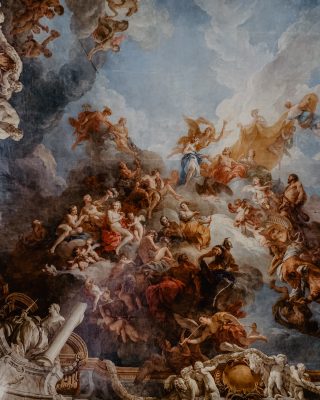
Finding community and humor in a changed classroom
When my classes switched to being remote this past spring due to COVID-19 I was not thrilled. I had really great classroom dynamics, especially in my Italian Renaissance Art (ART F364) class. I feared that this dynamic would completely fall apart as we all sheltered at home, but my fears were unfounded.

I made the decision to continue synchronous meetings with the 18 students enrolled in my Italian Renaissance Art class. I had only used Zoom a few times at this point for meetings that were set up by someone else (I hadn’t even signed up for my own account). However, I knew that you could screen share and this was crucial to the continuation of the class. You can’t teach art history without visuals and I needed to find a way to continue a discussion of the images in real-time.
I was worried that students would not have adequate bandwidth to join the class and initially I sent out my PowerPoint presentation before class so that students would be able to see the images more clearly without degradation from screen sharing. However, sending those files from my home internet proved to be a challenge and most students could not download them much less open them. I tried sending them in a compressed PDF format but the problems persisted. Eventually, everyone admitted to me that they weren’t even trying to open the files but were just looking at my screen share through Zoom.
There was a learning curve with Zoom but I don’t want to go into too much detail on that. What I want to do is share the successes. The class had been chatty before going remote and several kept that up during the Zoom sessions, but where the most conversation took place was in the chat. I struggled with how to deal with the chat window during our first few sessions, thinking that there was no way I could split my attention between what was said there and what I was saying about the images we were discussing. Once I relaxed and let the chat go wild, it turned out to be one of the best things about the class. And go wild it did! Many of the comments had to do with the works we were discussing but interspersed with that were comments about the pets that kept coming up on the screens, check-ins and discussions about how everyone was coping with the COVID-19 pandemic. And there was humor — lots of humor. It turns out that Renaissance paintings are really weird when you look at them closely.
At first I was apprehensive about the chat — after all, I would never allow students to freely talk to each other while I was lecturing — but I soon realized that my students really needed this. They needed to have a connection with each other and me that was not just about learning art history. Most of them were living with family and feeling isolated. The personal interactions that naturally took place on campus had disappeared and many were craving a feeling of interconnectedness. This class, and the chat in particular, gave them some semblance of normalcy, and it ended up being one of the most memorable that I have ever taught. Students asked me if we could continue to have a class through finals week. Ostensibly this was to make up for material lost during the extended spring break but we all admitted that we just didn’t want it to end. A group of students decided to form a virtual band and got buy-in from the rest of the class. I think they had practice out of class but of course, I wasn’t invited. During our final exam session — a roundtable discussion — they gave a performance of a song called “Expensive Paints” set to Lady Gaga’s “Poker Face.” It was a cacophony of instruments — a cello, jaw harp, spoons, a rain stick — but it was a blast and it was exactly what everybody needed.

Zoë Jones
Assistant Professor of Art History
Zoë Marie Jones is an assistant professor of art history at UAF.



Hello, here is my test comment.